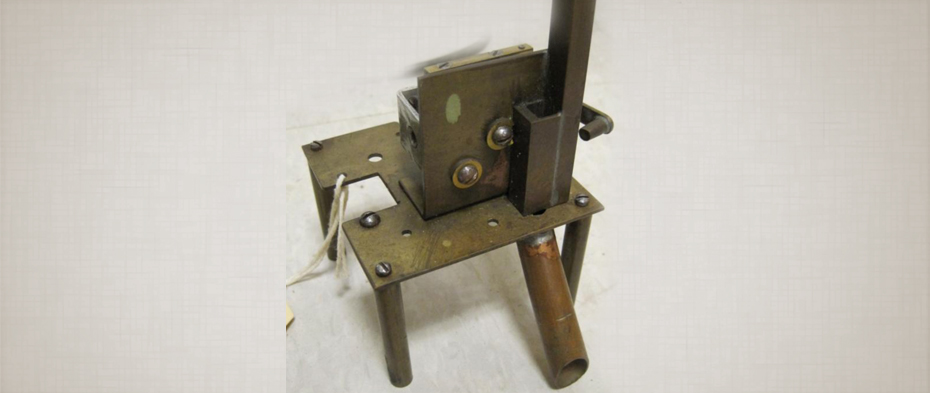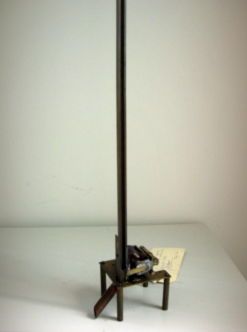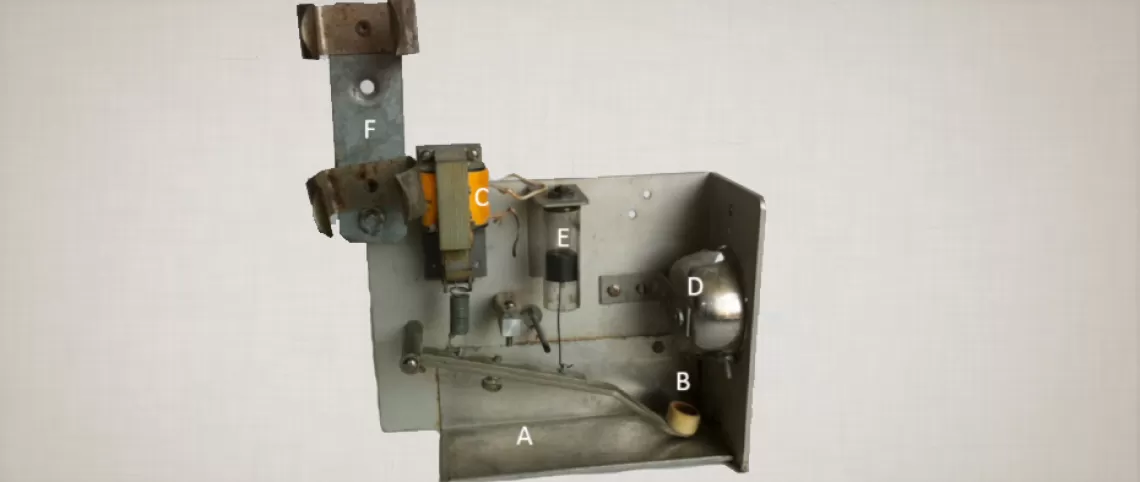
The Reinforcement Pill
The “Reinforcement Pill” and Its Impact on the Understanding of Behavior.
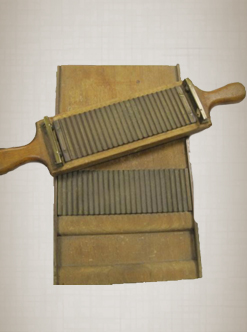 Reinforcement, which is central in the work of anyone interested in changing human behavior, is like the stars or the oceans –it is part of the natural world in which we all live. No one invented or discovered it, any more than anyone invented or discovered oceans or stars. Like these latter two natural features, though, people have learned, and have continued to learn, more about how to use reinforcement for the betterment of the human condition. Putting reinforcement under the scientific microscope, so to speak, began early in the 20th century, when educational psychologist Edwin L. Thorndike gave the world his law of effect. He observed, to put it succinctly, that behavior of animals and people followed by satisfying events is likely to be strengthened and thus repeated. Many had problems with defining “satisfying” and settled for a practical definition of reinforcement that emphasized only its effect on changing behavior, without reference to whether reinforcers were “satisfiers.”
Reinforcement, which is central in the work of anyone interested in changing human behavior, is like the stars or the oceans –it is part of the natural world in which we all live. No one invented or discovered it, any more than anyone invented or discovered oceans or stars. Like these latter two natural features, though, people have learned, and have continued to learn, more about how to use reinforcement for the betterment of the human condition. Putting reinforcement under the scientific microscope, so to speak, began early in the 20th century, when educational psychologist Edwin L. Thorndike gave the world his law of effect. He observed, to put it succinctly, that behavior of animals and people followed by satisfying events is likely to be strengthened and thus repeated. Many had problems with defining “satisfying” and settled for a practical definition of reinforcement that emphasized only its effect on changing behavior, without reference to whether reinforcers were “satisfiers.”
The leader of this practical approach to reinforcement was B. F. Skinner, who famously conducted experiments beginning in the early 1930s on reinforcement of lever pressing by rats. That early work of Skinner’s was really the beginning of our scientific understanding of the natural process of reinforcement. Skinner singlehandedly created a set of methods to study reinforcement under the controlled conditions of the laboratory. How he came to develop his methods has been described by him in detail in a fascinating article he titled “A case history in scientific method."
The first problem Skinner faced in studying reinforcement in the laboratory was finding a reliable model reinforcer, one that could be used repeatedly. He settled on food, but to use it repeatedly it had to be meted out in small packages. These packages turned out to be small pellets, about half the size of a baby aspirin (81 mg for the aspirin, 45 mg for the pellet). He needed both a way of making the pellets and a device to deliver them automatically to the rat when it made the appropriate response. Here we look at how he invented the food pellet, and in so doing made the scientific study of reinforcement a reality.
To make pellets, the food had to be turned into a wet mash and then formed into the appropriate shape and size. Skinner experimented with several recipes for food pellets, as the following quotations from his various articles and books suggest:
- “A standard food is prepared by pressing a stiff mash (McCullum’s formula) into strings, which are then dried and broken into pellets weighing 15 (in some cases 20) to the gram.”
- “The food is a commercial dog-biscuit, ground to a fine powder and made into uniform pellets with a pill machine.”
- “The food I have used is a standard dog biscuit (Purina Dog Chow), which is capable of maintaining rats in good health for several months without supplementary diet.”
- “The food used is prepared as pills by the Parke-Davis Company from a formula of several grains.”
(The Shaping of a Behaviorist – his autobiography): “In a book on the breeding and care of the white rat I found a formula for a balanced diet: wheat, corn, flax seed, and bone meal, with a bit of salt, cooked in a double boiler.
In Skinner’s own words, once he had the mash perfected, “[t]he mixture would have to be converted into pellets of uniform size, and I consulted a druggist, who showed me his pill machine. You laid a rope of stiff paste across a fluted brass plate and put a similar plate over it, face down. As you rolled the top plate back and forth, the material was converted into small pellets.”
A pill maker from this same era, used by Yale psychologist Clark Hull, is shown in the figure. The paste is spread into the lower grooved surface of the pill maker. Once spread, it was squeezed down with the other grooved surface to create cylinders. When the cylinders hardened, they were removed and sliced into the small pill-sized pellets Skinner described, ready to be delivered to the rats one at a time when they “did the right thing.”
The story of reinforcement thus began. As Skinner pursued how different ways of scheduling reinforcers changed their behavioral effects, other psychologists began thinking of reinforcers as things that reduce physical needs. But Skinner thought of reinforcers differently. His research led him to conclude that reinforcers were not limited to things. Food was a convenience for laboratory research, but the concept of reinforcement extended beyond physiological needs, and beyond rats working in small boxes. Skinner’s view of reinforcement was practical, functional, all-encompassing: only by thinking of reinforcers in terms of their effect could he include the unlimited variety of events that serve as reinforcers for humans. If something makes the behavior stronger when it is given following that behavior, it is a reinforcer. Nothing physiological, nothing about how something “feels” is needed. The sole index is its effect.
So, how do we discover these functional reinforcers? Well, we might give the person a choice between several items, but this doesn’t always work. Preference is relative to what the choices are. I may select walking over biking or swimming, but that does not mean that the opportunity to walk will necessarily reinforce another behavior, like completing some task. But, given a choice between exercising in any form or doing something else …. A more practical approach is to observe the person in their normal activities and see which ones the person seeks out. This is done formally and systematically by conducting a functional analysis, which essentially involves trying different events that might be likely to maintain the behavior.
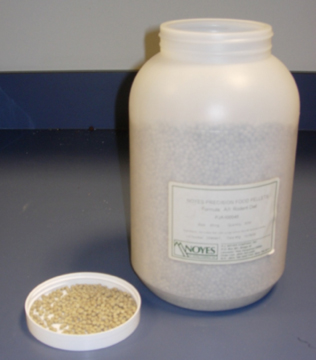 Food pellets can be arranged in one of two ways. They can be arranged one atop another such that when the pellet on the top or bottom is delivered, the next pellet in line is then pushed in place for the next delivery. This box-type arrangement is like a pez dispenser or a bullet clip for a pistol or rifle. The earliest feeders were of this type. The other, drum-type, arrangement is to have the pellets around a circle such that as the pellets rotate toward the delivery point, they are pushed out or released into the chamber. This drum-type arrangement is like that used in the infamous Thompson submachine guns (“Tommy guns”) used by Chicago gangsters of the 1920s.
Food pellets can be arranged in one of two ways. They can be arranged one atop another such that when the pellet on the top or bottom is delivered, the next pellet in line is then pushed in place for the next delivery. This box-type arrangement is like a pez dispenser or a bullet clip for a pistol or rifle. The earliest feeders were of this type. The other, drum-type, arrangement is to have the pellets around a circle such that as the pellets rotate toward the delivery point, they are pushed out or released into the chamber. This drum-type arrangement is like that used in the infamous Thompson submachine guns (“Tommy guns”) used by Chicago gangsters of the 1920s.
Food pellets for rats now are for the most part made commercially. They come in different sizes and of different compositions, from “regular” to those made with sucrose or saccharin (should one want to deliver a sweet taste but without nutritional value). Many labs order them in large quantities, such as 50,000 (50k), at a time. One such 50k container of 45 mg pellets (a standard size).
Learn more about pellets.
Liquid Reinforcer Dispenser for Rats
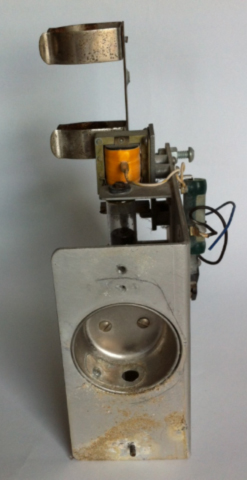 This device is used to dispense different type of liquids to rats. It is mounted in an rat operant conditioning chamber such that the rat’s view is that shown in the top photograph above. The bottom photopgraph shows its operational aspects. The device is 7 in (18.5 cm) long by 2.75 in (7 cm) wide by 5.38 in (14 cm) high. A plastic reservoir (often an upside down cover to a rectangular butter dish) was located along the flat metal piece at the bottom of the dispenser at “A” (there is no such dish in the photograp)h and filled with whatever liquid ws to be dispensed. The dipper located at “B” thus would be covered with the liquid in its deactivated position, as shown here. Operating the solenoid (C) raises the dipper to a small hole at the base of the shiny metal hopper (D). The dipper remains in this raised position until the solenoid is deactiviated, at which point it falls back into the liquid. The damper (E) prevents the dipper from descending too quickly and splashing liquid around the chamber. When thedipper is raised, the rat can drink the liquid by sticking its tongue through the small hole at the basse of the hopper (A in top photograph). This dispenser has been modified to include a bottle holder (F) so that there is even less a chance of the reservoir going dry. The device was suitable for dispensing a range of liquids, including water, mixtures of water and other substances like saccharin or alcohol, and sweetened condnsed milk (a preferred reinforcer among many rats!).
This device is used to dispense different type of liquids to rats. It is mounted in an rat operant conditioning chamber such that the rat’s view is that shown in the top photograph above. The bottom photopgraph shows its operational aspects. The device is 7 in (18.5 cm) long by 2.75 in (7 cm) wide by 5.38 in (14 cm) high. A plastic reservoir (often an upside down cover to a rectangular butter dish) was located along the flat metal piece at the bottom of the dispenser at “A” (there is no such dish in the photograp)h and filled with whatever liquid ws to be dispensed. The dipper located at “B” thus would be covered with the liquid in its deactivated position, as shown here. Operating the solenoid (C) raises the dipper to a small hole at the base of the shiny metal hopper (D). The dipper remains in this raised position until the solenoid is deactiviated, at which point it falls back into the liquid. The damper (E) prevents the dipper from descending too quickly and splashing liquid around the chamber. When thedipper is raised, the rat can drink the liquid by sticking its tongue through the small hole at the basse of the hopper (A in top photograph). This dispenser has been modified to include a bottle holder (F) so that there is even less a chance of the reservoir going dry. The device was suitable for dispensing a range of liquids, including water, mixtures of water and other substances like saccharin or alcohol, and sweetened condnsed milk (a preferred reinforcer among many rats!).
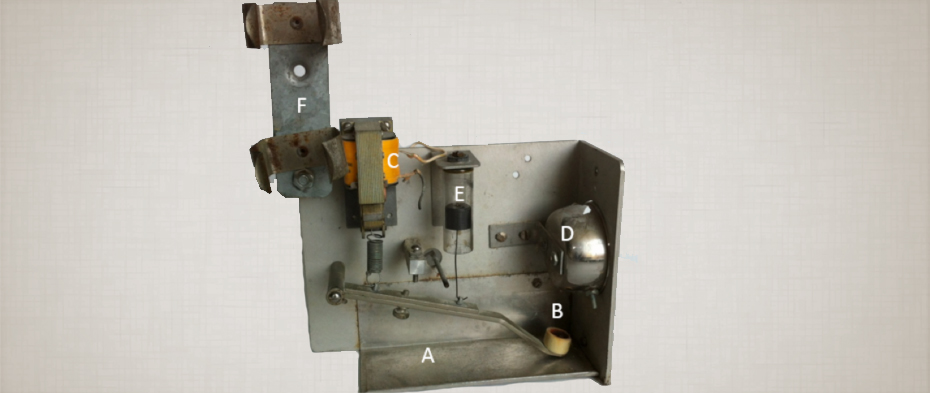
Early Box Food Pellet Dispenser
An Early Box or Clip-Type Food Pellet Dispenser
The vertical tube of pellet dispenser is loaded with pellets through its top, in much the same way that bullets are loaded into a clip. When the relay at the bottom of the tube is operated, a round brass rod connected to its armature (best seen in the close-up photograph of the bottom part of the feeder) pushes the pellet into a tube that is connected to the rat chamber.
